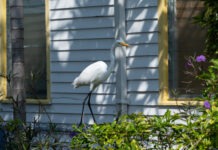I was sitting on the porch the other morning, drinking my coffee at a surprisingly early hour, considering what a late night it had been, when I heard it – a common ground-dove.
The call sounds like the world’s least urgent alarm — a low, soft clarion that’s been turned from 11 down to one. It is a persistent single syllable in a low register that sounds borderline subsonic and tends to get repeated, according to the data, one to 13 times, though sometimes it can seem like forever. The call is so unaccented and so devoid of intensity, you’re not sure you’re hearing anything first. It works its way into your consciousness slowly, like water carving out a canyon.
Using anything but vowels to spell it out seems overly dramatic and maybe a little disrespectful, though opinions on that may vary, as the Sibley guide describes it as a hoooip hoooip hoooip, and Cornell University’s “Bird of the World” goes with woot woot woot. If you ever decide to track down a recording of it, keep in mind it was produced using a parabolic mic in close quarters, so that’s not how it sounds in the real world.
Once you hear it, though, once you know what it is, it tends to underscore things, like swelling violins in a movie, or a half-formed thought you can’t quite shake.
It was a sound that vexed me when I first took up birding. I kept hearing it in the parking lot over at the Harris School, where I used to have an office, and for the longest time I wasn’t sure it was even a bird. Or, again, if I was even hearing anything. And even after I got close to what I was pretty sure was the source, then saw a common ground-dove low in the bushes, I did not firmly believe the connection. It took a couple times and maybe seeing their throat move.
I suppose the fact that I can now recognize the call so readily could be taken as empirical proof that I do occasionally learn things from experience.
I’ve been reading a lot of John le Carré over the last few years, mostly the George Smiley novels. The character Smiley is pretty much the anti-James Bond – short, round, and nebbishy, with thick glasses, so unassuming that most people don’t take him seriously, or even notice him, until he gingerly pulls the string that unwinds their evil scheme. (When he drinks it’s not for bravado, but often because his wife is cheating on him with other spies.)
Almost as much as the novels, I love the film versions, among them the two mini-series from the 1980s with Alec Guinness, who was trying to shed his Obi Wan persona, and the 2011 version of “Tinker Tailor Soldier Spy” starring Gary Oldman and an all-star cast of British actors, or at least an all-star cast of white, male British actors. (The spy service was apparently not all that diverse back in the day.)
The 2011 movie is interesting for its complexity, but also its near pornographic love of analog spy equipment and all the switches, wires, microphones and spinning tape reels that come with it. The film also has an amazing color palette, a fantasia in brown, beige, sepia, nutmeg, ecru and taupe.
Which gets me back to common ground-doves. I’ve been thinking of them lately as the George Smileys of the dove world, not because of their spying skills – though who knows what information they collect – but because everything about their persona, as a species, seems designed to make them underestimated and largely unnoticed. They are short, round, nebbishy and unassuming. And their color palette is also a fantasia in brown, beige, sepia and nutmegs, etc., accented by a blur of warm rust color in their primary feathers when they fly.
Common ground-doves are not the smallest doves in the world, but I’m pretty sure they are the smallest doves found in the U.S., and they are definitely the smallest doves found in the Keys – about 6 inches long and weighing just a little more than an ounce.
They tend to stick to the ground or the low bushes. They tend not to respond to possible threats overly quickly, as if not wanting to draw attention in case the possible threats turn out to be not actual threats. Sometimes, if you are not paying attention, it’s possible to confuse them with rocks.
The bird was first described to science in 1758 by the Swedish naturalist Carl Linnaeus, who classified it in the genus Columba. Later it was reclassified into the genus Columbina, a category of smaller doves, which was created in 1825 by Johann Baptist von Spix. I mention this mostly because Johann Baptist von Spix is just such an excellent name.
The species’ two colloquial names were the tobacco dove – not for their tobacco-like coloring, but for their fondness of nesting near the crop – and the moaning dove.
Birds vocalize for a few reasons: to attract or entice a mate, to stake out territory, to warn each other about predators, or to tell each other where they are.
In the Keys, common ground-doves tend to make their oh-so-subtle call year round. Which would maybe make you think they do it to hold territory. But their calls are really all about finding love and getting some.
Common ground-doves generally live in warm weather places that have a plentiful supply of food – in their case, mainly the seeds of weeds and wild grasses, but also insects, fruits and berries. Predominantly they don’t migrate, which means they can breed any time of year. And they do. A common ground-dove pair can hatch up to four two-egg clutches in a single year. Most of the year, the only time they get quiet is when they are incubating eggs.
The call they make is actually considered an advertisement for courtship. Common ground-doves have a thriving and active sex life.
It’s come out in recent months – largely due to a book chronicling all the details – that John le Carré (real name: David Cornwell) was a serial philanderer, that much of the tradecraft he depicted in his books he employed while having affair after affair during the combined 66 years of his two marriages. And it might be tempting to draw some parallels between le Carré’s proclivities and the romantic stealthiness of common ground-doves.
But this is the thing: common ground-doves are hardcore monogamists. Not like most species, where monogamy is something that may only last a season. Common ground-doves form pair bonds that last a lifetime. And once a bond is established, they embrace the roles of homebodies, working very hard to avoid everyone else’s business.
Unlike George Smiley or John le Carré, they seem to have a pretty satisfactory home life. They might just be the real romantics after all.


























